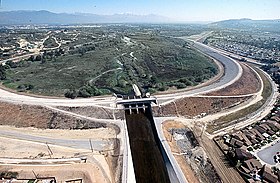TheWhittier Narrowsis anarrowsorwater gapin theSan Gabriel ValleyofLos Angeles County, California,United States, between thePuente Hillsto the east[2]and the Montebello Hills to the west.[3]The gap is located at the southern boundary of the San Gabriel Valley,[4]through which theRio Hondo[5]and theSan Gabriel Riverflow to enter theLos Angeles Basin.The Narrows is located near the convergence ofInterstate 605(the San Gabriel River Freeway) andCalifornia State Route 60(the Pomona Freeway).
| Whittier Narrows | |
|---|---|
 Aerial view ofWhittier Narrows Damfrom downstream looking upstream through the gap. | |
| Elevation | 183 ft (56 m)[1] |
| Traversed by | |
| Location | North ofWhittier, California |
| Range | Puente Hills/ Montebello Hills |
| Coordinates | 34°01′45″N118°02′58″W/ 34.02917°N 118.04944°W[1] |
History
editTheTongvavillage ofShevaangawas located in the northern areas of the Whittier Narrows.[6][7]The first European land exploration ofAlta California,the SpanishPortolá expedition,traversed Whittier Narrows on its return journey toSan Diego.He wrote that the natives "presented us fish, hare, nuts, pine nuts, acorns, and other seeds prepared after their fashion".[8]On the outbound journey, the party had followed San Jose Creek, reaching the San Gabriel River north of the Narrows.FranciscanmissionaryJuan Crespinoted in his diary, "We started out in the morning through the gap of the valley of San Miguel [now San Gabriel], which is very full of trees. We traveled a long while to the southwest on the edge of the stream, which, rising from a copious spring of water in the same gap, merits now the name of river; its plain is covered with willows and some slender cotton woods."
From the explorationMission Viejawas built at Whittier Narrows in 1771. A flood in 1776 caused Mission Vieja to move toMission San Gabriel Arcángelin San Gabriel.[9]Whittier Narrows was the meeting point for boundary corners of several land-grantranchos,created during the Spanish-Mexican era, including theRancho Paso de Bartolo.
On October 1, 1987 at 7:42 a.m. PDT, the 5.9 Mw Whittier Narrows earthquakeaffected theGreater Los Angeles Areawith a maximumMercalli intensityof VIII (Severe).
In October 2008, a proposed new interpretive center drew controversy over the potential destruction of a large amount of existing wildlife habitat.[10]
Whittier Narrows Recreation Area
editThe Whittier Narrows Recreation Area is a 1,500-acre (6.1 km2) multi-use facility, mostly in an unincorporated part ofLos Angeles County,containing North Lake, Center Lake, and Legg Lake (where radio-controlled model speedboats may be operated), a rifle and pistol shooting range, numerous softball and soccer fields with picnic tables, a paved airstrip for radio-controlled hobby aircraft, atether carrace track, a USA BMX race track, and a connector trail between the Class IRio Hondo bicycle pathand theSan Gabriel River bicycle path.[11]
The park is roughly bordered by Garvey Avenue and San Gabriel Blvd to the north and west and Durfee Avenue and Santa Anita/Merced Avenues to the south and east. A convenient point of access is the Rosemead Blvd (State Route 19) exit south from thePomona (60) Freeway.
Within the Recreation Area is the Whittier Narrows Nature Center, which contains exhibits about the plants and animals of the river environment, including live displays. The center offers public programs, lectures, ranger tours and education programs.
Dragon sculptures by Benjamin Dominquez can be seen here; others are at Laguna de San Gabriel Nautical Playground atVincent Lugo Parkin San Gabriel.[11]
Whittier Narrows Dam
editThe Whittier Narrows Dam is a flood control and water conservation project constructed and operated by the U.S. Army Corps of Engineers, Los Angeles District. It collects runoff from the uncontrolled drainage areas upstream along with releases from theSanta Fe Dam,and can redirect flows into the Rio Hondo or the downstream San Gabriel. It was completed in 1957.[12]
See also
editReferences
edit- ^ab"Delaware Water Gap".Geographic Names Information System.United States Geological Survey.RetrievedAugust 29,2008.
- ^"Puente Hills".Geographic Names Information System.United States Geological Survey,United States Department of the Interior.
- ^"Montebello Hills".Geographic Names Information System.United States Geological Survey,United States Department of the Interior.
- ^"San Gabriel Valley".Geographic Names Information System.United States Geological Survey,United States Department of the Interior.
- ^"Rio Hondo".Geographic Names Information System.United States Geological Survey,United States Department of the Interior.
- ^"Gabrielino/Tongva Nation of the Greater Los Angeles Basin".NAHC Digital Atlas.RetrievedApril 25,2023.
- ^Greene, Sean; Curwen, Thomas (May 9, 2019)."Mapping the Tongva villages of L.A.'s past".Los Angeles Times.RetrievedApril 25,2023.
- ^Sahagún, Louis; Greene, Sean (October 9, 2023)."Tribal leaders and researchers have mapped the ancient 'lost suburbs' of Los Angeles".Los Angeles Times.RetrievedOctober 9,2023.
- ^Bolton, Herbert E. (1927).Fray Juan Crespi: Missionary Explorer on the Pacific Coast, 1769–1774.HathiTrust Digital Library. p. 270.RetrievedFebruary 21,2019.
- ^Sahagún, Louis (October 12, 2008)."Plans for major overhaul of Whittier Narrows nature preserve stir passions".Los Angeles Times.RetrievedOctober 12,2008.
- ^abFleming, Charles(2015). "22".Secret walks: a walking guide to the hidden trails of Los Angeles.Solana Beach, California.ISBN978-1-59580-821-9.OCLC912325615.
{{cite book}}:CS1 maint: location missing publisher (link) - ^Sahagún, Louis (February 18, 2019)."Rare L.A. mega-storm could overwhelm dam and flood dozens of cities, experts say".Los Angeles Times.RetrievedFebruary 20,2019.